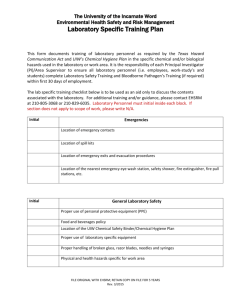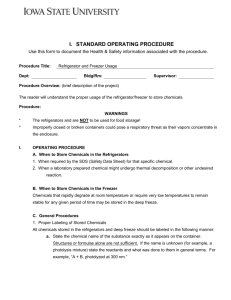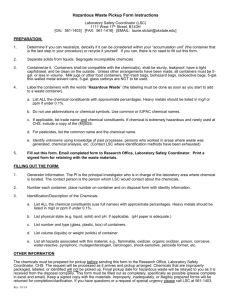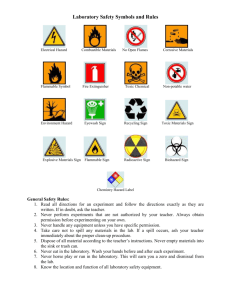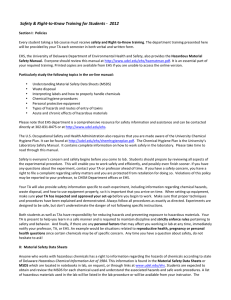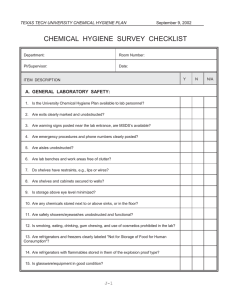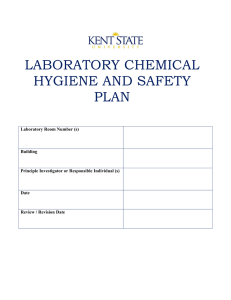Lab Safety Quiz - University of Montana
advertisement
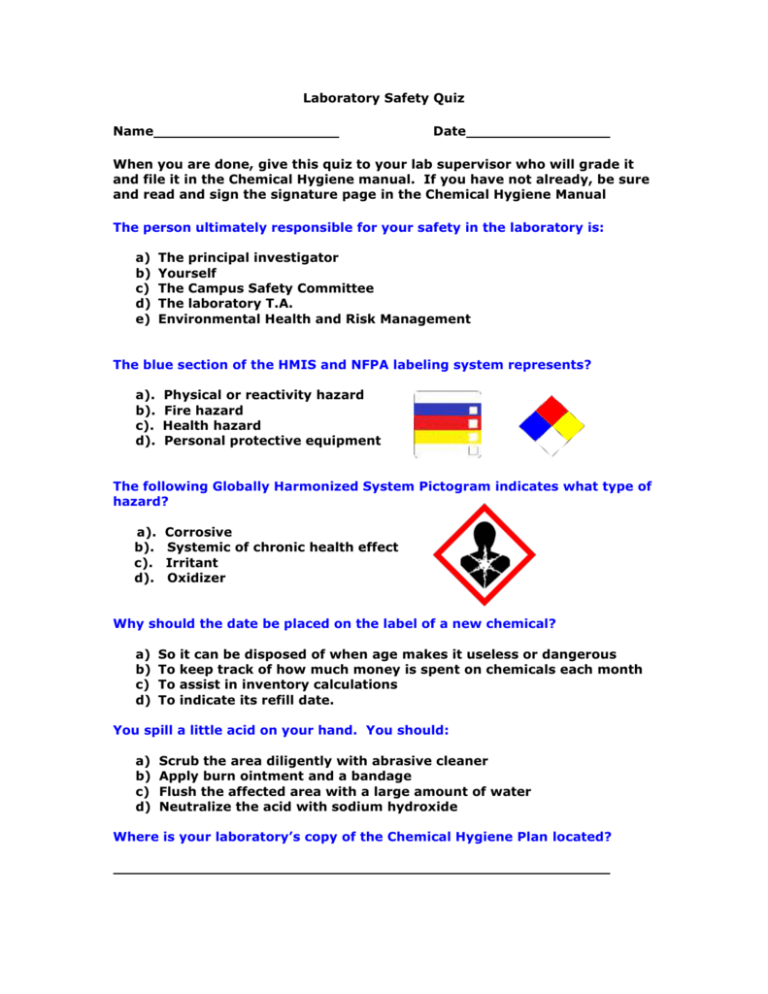
Laboratory Safety Quiz Name Date When you are done, give this quiz to your lab supervisor who will grade it and file it in the Chemical Hygiene manual. If you have not already, be sure and read and sign the signature page in the Chemical Hygiene Manual The person ultimately responsible for your safety in the laboratory is: a) b) c) d) e) The principal investigator Yourself The Campus Safety Committee The laboratory T.A. Environmental Health and Risk Management The blue section of the HMIS and NFPA labeling system represents? a). b). c). d). Physical or reactivity hazard Fire hazard Health hazard Personal protective equipment The following Globally Harmonized System Pictogram indicates what type of hazard? a). b). c). d). Corrosive Systemic of chronic health effect Irritant Oxidizer Why should the date be placed on the label of a new chemical? a) b) c) d) So To To To it can be disposed of when age makes it useless or dangerous keep track of how much money is spent on chemicals each month assist in inventory calculations indicate its refill date. You spill a little acid on your hand. You should: a) b) c) d) Scrub the area diligently with abrasive cleaner Apply burn ointment and a bandage Flush the affected area with a large amount of water Neutralize the acid with sodium hydroxide Where is your laboratory’s copy of the Chemical Hygiene Plan located? There is a container on the lab bench containing some unknown chemical. You should: a) If it is aqueous, it can always be dumped down the sink b) Move it out of the way in case it is dangerous. The rightful owner will claim it eventually. c) If it is solvent based, it can be dumped into the waste solvent drum. d) Leave it. Find your lab supervisor and ask what to do. If you are the lab supervisor, remove the container (noting its location), and try to get some idea what could be in the container so you know how to properly dispose of it. You are really curious about chemistry and chemical reactions. You wonder what would happen if you mixed chemicals in a different way or introduced something new into a procedure. You should: a) Mixing and matching chemicals in small quantities will not lead to a dangerous reaction, so you can proceed with laboratory size quantities. b) Refer to the first section of an MSDS for important reaction information. c) Make sure your supervisor has full knowledge of what you want to do and that together you have determined exactly how you will or will not proceed d) Curb your enthusiasm. Make sure you understand the properties of the materials you are working with and have all necessary personal protective gear on then give it a try—this is how great discoveries are made When disposing of chemicals, it is appropriate to: a) b) c) d) Separate alkaline corrosives from acidic corrosives Separate the waste according to hazard class Pour compatible chemicals into a common container Depending on the chemical all of the above but I should check the UM Hazardous Material Management Plan before I decide Before using gloves for protection, one should check them for: a) b) c) d) e) Cracks or holes Proper fit Appropriateness for the task to be performed Compatibility with the chemical that is to be used all of the above Compressed gas cylinders must have a cap in place before being transported. a) True b) False A fume hood is used: a) b) c) d) For conducting reactions that may result in an explosion For disposal of toxic liquids and gases To control exposure to hazardous liquids and gases With the sash in a maximally open position to allow the greatest air flow Which of the following is a common way for hazardous chemicals to enter the body: a) b) c) d) e) injection ingestion inhalation absorption (e.g. through skin or eyes) all of the above When should you look up a chemical’s MSDS? a) b) c) d) e) f) When you are not familiar with the chemical’s properties When you need to know how the chemical was made when you use a chemical for the first time when you need to know what PPE to wear Both a, c and d All of the above Regulations require that all containers in your lab must be labeled with the name of the contents. Exceptions to this are containers that will be used and emptied within one work shift and under the control on only one individual. Labeling is necessary to ensure that: a) In the event of a spill, the material can be more easily identified b) So that unlabeled materials are not inadvertently mixed causing a violent reaction and possibly injury c) Both a and b. d) All containers are labeled. Containers of hazardous waste must: a) be compatible with the contents b) be labeled with the words “hazardous waste” or “waste-name of c) d) contents” such as waste toluene be stored where they will not be tipped over or broken all of the above Who must leave the building when the emergency alarm sounds? a) b) c) d) All students Everyone Anyone not an employee of UM Everyone except the principal investigator In the event of an emergency that requires outside assistance in your lab your first call should be to: a) University of Montana switchboard b) 4000, the emergency number for the UM Public Safety Office. They will immediately dispatch fire and medical as well as activate the inhouse emergency response folks as necessary c) EHRM d) The principal investigator How do you access Material Safety Data Sheets for the chemicals in your lab? Please give this completed quiz to your supervisor.

